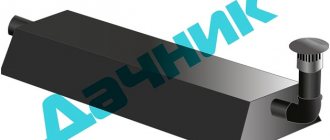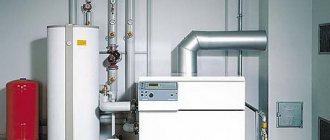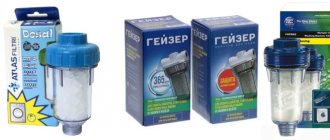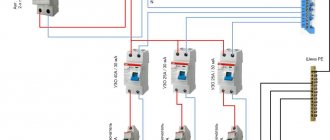The water supply system of a private house is impossible without a pump. But you have to somehow turn it on and off, and make sure that it doesn’t work in the absence of water. A water pressure switch is responsible for turning the pump on and off, and the presence of water should be monitored by protection against dry running of the pump.
No matter where the pump pumps water from, at times a situation arises that the water has run out - if the flow rate of a well or borehole is small, you can simply pump out all the water. If water is pumped from a centralized water supply, its supply may simply be stopped. The operation of the pump in the absence of water is called dry running.
What is dry running of a pump?
The term “idling” is sometimes used, although this is not entirely correct. In order for the water supply at home to work normally, you need not only a pump, but also a dry water protection system and automatic on-off switching.
What's wrong with dry running, other than wasting electricity? If the pump operates in the absence of water, it will overheat and burn out - the pumped water is used to cool it. No water - no cooling.
The engine will overheat and burn out. Therefore, protection against dry running of the pump is one of the components of the automation that will have to be purchased in addition. There are, however, models with built-in protection, but they are expensive. It is cheaper to buy additional automation.
How can you protect the pump from dry running?
There are several different devices that will turn off the pump if there is no water:
- dry running protection relay;
- water flow control devices;
- water level sensors (float switch and level control relay).
All these devices are designed for one thing - turn off the pump when there is no water. They just work differently and have different areas of application. Next, we will look at the features of their work and when they are most effective.
Dry running protection relay
A simple electromechanical device monitors the presence of pressure in the system. As soon as the pressure drops below the threshold, the power supply circuit is broken and the pump stops working.
The relay consists of a membrane that responds to pressure and a contact group that is normally open. When the pressure decreases, the membrane presses on the contacts, they close, turning off the power.
When is it effective?
The pressure to which the device responds is from 0.1 atm to 0.6 atm (depending on factory settings). This situation is possible when there is little or no water, the filter is clogged, or the self-priming part is too high. In any case, this is a dry running condition and the pump must be turned off, which is what happens.
An idle speed protection relay is installed on the surface, although there are models in a sealed housing. It works normally in an irrigation scheme or any system without a hydraulic accumulator. It works more efficiently with surface pumps when a check valve is installed after the pump.
When it does not guarantee shutdown in the absence of water
You can install it in a system with HA, but you will not get 100% protection against dry running of the pump. It's all about the particular structure and operation of such a system. Place a protective relay in front of the water pressure switch and the hydraulic accumulator.
In this case, there is usually a check valve between the pump and the protection, that is, the membrane is under pressure created by the hydraulic accumulator. This is a common scheme. But with this method of switching on, it is possible that a working pump in the absence of water will not turn off and will burn out.
For example, a dry running situation has been created: the pump is turned on, there is no water in the well/borehole/tank, and there is some water in the accumulator. Since the lower pressure threshold is usually set to about 1.4-1.6 atm, the protective relay membrane will not work. After all, there is pressure in the system. In this position, the membrane is pressed out, the pump will run dry.
It will stop either when it burns out or when most of the water supply is used up from the hydraulic accumulator. Only then will the pressure drop to critical and the relay will be able to operate.
If such a situation arose during the active use of water, nothing terrible will happen in principle - several tens of liters will dry up quickly and everything will be normal.
But if this happened at night, they flushed the water in the tank, washed their hands and went to bed. The pump turned on, but there was no signal to turn off. By the morning, when water collection begins, it will be inoperative. That is why in systems with hydraulic accumulators or pumping stations it is better to use other devices to protect against dry running of the water pump.
Water flow control devices
In any situation that causes the pump to run dry, there is insufficient or no water flow. There are devices that monitor this situation - relays and water flow controllers. Flow relays or sensors are electromechanical devices, controllers are electronic.
Flow relays (sensors)
There are two types of flow sensors - petal and turbine. Petal has a flexible plate that is located in the pipeline. In the absence of water flow, the plate deviates from its normal state, contacts are activated, turning off the power to the pump.
Turbine flow sensors are somewhat more complicated. The basis of the device is a small turbine with an electromagnet in the rotor. When there is a flow of water or gas, the turbine rotates, creating an electromagnetic field, which is converted into electromagnetic pulses read by the sensor. This sensor, depending on the number of pulses, turns on/off the power to the pump.
Flow controllers
Basically, these are devices that combine two functions: dry-running protection and a water pressure switch. In addition to these features, some models may have a built-in pressure gauge and check valve. These devices are also called electronic pressure switches.
These devices cannot be called cheap, but they provide high-quality protection, serving several parameters at once, ensuring the required pressure in the system, turning off the equipment when there is insufficient water flow.
Name Functions Dry running protection activation parameters\Connection dimensions\Country/manufacturer\Price
| BRIO 2000M Italtecnica | Pressure switch + flow sensor | 7-15 sec | 1″ (25 mm) | Italy | 45$ |
| AQUAROBOT TURBIPRESS | Pressure switch + flow switch | 0.5 l/min | 1″ (25 mm) | 75$ | |
| AL-KO | Pressure switch + check valve + dry-running protection | 45 sec | 1″ (25 mm) | Germany | 68$ |
| Gilex automation unit | Pressure switch + idle protection + pressure gauge | 1″ (25 mm) | Russia | 38$ | |
| Aquario automation unit | Pressure switch + idle protection + pressure gauge + check valve | 1″ (25 mm) | Italy | 50$ |
In the case of using an automation unit, the hydraulic accumulator is an extra device. The system works perfectly when a flow appears - the opening of a tap, the activation of household appliances, etc.
But this is if the pressure reserve is small. If the gap is large, both a HA and a pressure switch are needed. The fact is that the pump shutdown limit in the automation unit is not adjustable.
The pump will turn off only when it has created maximum pressure. If it is taken with a large headroom, it can create excess pressure (optimal - no more than 3-4 atm, anything higher leads to premature wear of the system). Therefore, after the automation unit they install a pressure switch and a hydraulic accumulator.
This scheme makes it possible to regulate the pressure at which the pump turns off.
Water level sensors
These sensors are installed in a well, borehole, or container. It is advisable to use them with submersible pumps, although they are compatible with surface pumps. There are two types of sensors - float and electronic.
Water level sensors
These sensors are installed in a well, borehole, or container. It is advisable to use them with submersible pumps, although they are compatible with surface pumps. There are two types of sensors - float and electronic.
Float
There are two types of water level sensors - for filling the container (protection against overflow) and for emptying - just protection against dry running. The second option is ours, the first is needed when filling the pool. There are also models that can work either way, but the principle of operation depends on the connection diagram (included in the instructions).
Operating principle of a float switch
The principle of operation when used to protect against dry running is simple: as long as there is water, the float sensor is raised up, the pump can operate, as soon as the water level has dropped so much that the sensor has dropped, the contactor opens the pump power circuit, it cannot turn on until until the water level rises. To protect the pump from idling, the float cable is connected to the open phase wire.
Level control relay
These devices can be used not only to control the minimum water level and dry running in a well, well or storage tank. They can also control overflow (overflow), which is often necessary when there is a storage tank in the system, from which water is then pumped into the house or when organizing a water supply for a swimming pool.
Electrodes are lowered into the water. Their number depends on the parameters they monitor. If you only need to monitor the presence of a sufficient amount of water, two sensors are enough. One - goes down to the level of the minimum possible level, the second - basic - is located slightly lower. The work uses the electrical conductivity of water: while both sensors are immersed in water, small currents flow between them. This means that there is enough water in the well/well/container. If there is no current, this means that the water has dropped below the minimum level sensor. This command opens the pump's power supply circuit and stops working.
The same device can control different levels, including the minimum
These are the main ways in which protection against dry running of a pump is organized in the water supply systems of a private home. There are also frequency converters, but they are expensive, so it is advisable to use them in large systems with powerful pumps. There they quickly pay for themselves due to energy savings.
Dry running relay (sensor) for pump: operating principle
Pumping equipment operates correctly only when the flow of liquid through it is constant. If the liquid supply stops, dry running occurs, and, as a result, pump breakdown.
To prevent the pump from running dry, special devices are installed on the water supply system.
Dry running relay: purpose and design
There are several types of devices that will turn off equipment without water supply:
- dry running relay for pump;
- liquid flow control sensor;
- water level sensor.
- Each of these devices has a different scope and operating principle.
- The dry-running protection relay is a simple electromechanical device that monitors the presence of pressure in the water supply: if the pressure drops below the permissible level, the electrical circuit will open and the pump will turn off.
The relay device contains a sensitive membrane that responds to pressure and a contact group that is open in the normal state. As soon as the pressure drops, the membrane presses on the contacts, they close, and the power supply is turned off.
A drop in pressure is possible when the water supply in the pipeline stops, the filter becomes clogged with debris, or the suction pipe is above the liquid level. In each of these cases, a “dry running” of the pump occurs, which must be stopped, which is what the protective element does.
The operating pressure of the medium to which the dry-running relay reacts is set by the manufacturer and ranges from 0.1 atmospheres to 0.6 atmospheres. The idle relay is installed on the surface, but there are also models for internal placement in a sealed housing.
Installation
The device operates normally in any pipeline design that does not include a hydraulic accumulator. It can also be installed in conjunction with a hydraulic accumulator, but such a scheme will not provide complete protection against dry running of the pump.
The reason is the peculiarity of the structure and operating principle: the protective element is installed in front of the fluid pressure switch and the hydraulic accumulator, and a check valve is mounted between the pumping unit and the protective device.
In this case, the membrane of the device is constantly under pressure, which is created by the hydraulic accumulator. This is a standard scheme, but sometimes situations arise when a running pump does not turn off when the water flow stops and fails.
For example, a dry running situation has arisen: the pump is turned on, the container or well is almost empty, but there is a small amount of liquid in the battery. Since the lower pressure threshold is set to work at 1.4-1.6 atmospheres, it is there, but the membrane will be pressed out, and the pump will continue to idle.
It will stop working when most of the water from the accumulator is pumped out or when the engine burns out. This means that the pressure in the pipeline has dropped to a critically low level and the protective relay has tripped. Based on this, in systems with hydraulic accumulators it is advisable to install other devices to protect against dry running of the pump.
It is most effective to connect a dry-running relay paired with a surface pumping unit, when the check valve is installed after the pumping equipment.
Float switch
A float switch is the simplest and cheapest way to protect the circulation pump from overheating and damage when running dry. The advantage of the device is that it can be used as a working medium level sensor and as an actuator.
They install switches in tanks, wells, reservoirs and use them to control household and industrial pumps in water supply and sewer lines. The required level of switch operation is determined by the length of the cable.
Several float switches can be placed in one container, each of which will perform a separate function to control the main or backup pump equipment.
Dry-running float sensors come in light and heavy sizes. The former are used for supplying and draining water, the latter - in sewers and drainage pipelines.
For correct operation of the device, a minimum well diameter of 40 cm is required. This feature does not allow float switches to be considered a universal means of protecting the pump from running dry.
Safety pressure switch
The device is a conventional pressure switch, equipped with additional protection against idling when the pressure drops below factory settings.
This pressure switch controls the switching on and off of a surface or well pump if the pipeline diagram includes a hydraulic accumulator or a connection to an automatic pumping station is provided. The relay operates at 0.4-0.6 atmospheres. This parameter is set at the factory and cannot be changed.
If pressure fluctuations inside the pipeline are within specified limits, then the pressure switch does not operate and the pump operates normally. When the pressure drops to the set values, which happens in the absence of water, the dry running sensor is activated, the contacts supplying the circuit are opened, and the device for pressure movement of liquid is turned off.
The process of starting the pump is carried out only manually by pressing the lever. Before this, the cause of the engine stopping is determined and eliminated. A prerequisite during startup is to fill the pump with water.
Which protective device should you choose?
The choice of a device to protect the pump from dry running is determined by the model of the pump itself and the tasks it needs to cope with. The optimal option is to use a dry-running sensor for the pump in the form of a float and a pressure switch. Connecting these devices to the pipeline will completely reduce the risk of pump equipment breakdown.
How to install correctly
As mentioned above, a dry running sensor for a pumping station is installed in conjunction with a pressure switch and mounted on the supply pipeline.
- First of all, it should be noted that the entire installation process is carried out with an empty pipeline and pumping station.
- The dry-running relay itself must be connected to the water supply line through a fitting, usually a tee. Installation must be carried out according to all plumbing standards, that is, with complete sealing of the joints.
- It is very important to make the electrical connections of the devices correctly. As already mentioned, in this system the connection must be serial. By the way, this is clearly visible in the photo below.
- All that remains is to connect the wires through the terminal box (contact group), which must be routed through the sealed leads. It is clear that you need to work with electrical wiring only when the power to the unit is turned off.
Electrical connection diagram for dry running relay
It should be noted that the diagram shown above is not standard. That is, it is not necessary to install a dry-running relay before the pressure switch. These devices can be swapped. The main condition is the sequential installation of both in the electrical supply circuit. Moreover, many models of pumping stations are already equipped at the factory with a pressure switch, which is installed directly at the outlet supply pipe of the pumping unit.
Dry running relay (sensor) for pump: operating principle
For long-term and trouble-free operation of the pump (pumping station), a prerequisite for operation is the presence of a sufficient amount of water.
Regardless of where the intake comes from (well, well, open reservoir, centralized or drainage systems), pumping equipment must be equipped with idle protection.
This is due to the fact that water, when passing through the pump, ensures its lubrication and cooling. If there is no water or insufficient quantity, the operating pump overheats and fails.
In order to prevent damage that is not covered by the manufacturer's warranty, you should install a relay to protect against dry running of the pump.
Causes of dry running
It is necessary to connect a dry-running relay to protect pumping equipment in the following cases:
- when the productivity (power) of a well pump significantly exceeds the resource capacity for self-regeneration of a sufficient volume of water in the well;
- the natural water level in the source is significantly lower than the installation level of the pump;
- there is constant clogging of the intake pipe or filtration mesh with sand, silt, and foreign objects;
- the tightness of pipes and their connections is broken due to the physical influences of the soil or due to improper installation;
- the circulation pump operates when there is low water pressure or insufficient quantity in heating (cooling) systems;
- Water is taken from a source that is being filled - a well (well) that slowly restores the water level, a storage tank, or an unstable water supply system.
Connecting the idle relay to the pumping station is a prerequisite, since it operates in automatic mode without third-party control.
Dry running protection devices
The main devices that exclude the possibility of pumping equipment operating without water in automatic mode include:
- dry running sensor for pump;
- dry running relay for pump;
- pressure switch;
- float type switch.
Under certain conditions, sensors and relays interrupt the power supply to the pump motor, causing it to stop. Triggering of the protection is determined by the following parameters:
- water level;
- pressure at the outlet pipe;
- by the strength of the water flow.
Combined control of several parameters simultaneously is possible.
Float sensor
Float-type dry running sensors work effectively when installed in wells, drainage systems and storage tanks. The actuation process (power outage) occurs when the water level in the source drops to a minimum value.
When, along with the receding water, the float drops to the lower operating level, the contacts in the power supply phase of the pump open, which leads to its stop.
The float sensor can be connected to submersible or surface pumps. In this case, its location should be above the bottom valve or protective grille of the suction pipe with detection of triggering when there is insufficient water level.
Installation of such a sensor is not possible when drawing water from wells and centralized water supply systems.
Level relay
Using this device, the water level in the source (container) is monitored. When the level drops to a critical value, the control relay is turned on to regulate the operation of the flow valves or turn off the pump.
The main advantage of such protection is that the power supply to the pump is turned off before it starts running in idle mode.
The level switch consists of an electronic board and three electrodes (sensors), which are installed at different heights in close proximity to each other.
The electrodes, while immersed, exchange low-frequency currents, since water is a good conductor of electricity.
When the water level drops to the lowest control sensor, the electrical connection between the electrodes is interrupted, which causes the relay to operate to stop the pumping device. When the operating water level is restored, the pump turns on again.
Pressure switch
The operating principle of the pressure switch is based on determining sufficient pressure (from 1 bar) at the outlet pipe of the water pumping device. If the pressure drops below 0.5 bar, the contacts open using a pressure switch.
When the pressure is restored, with sufficient pressure for safe operation of the pump, you should manually fill the dry pump with water and turn it on yourself.
Pressure switches are used when installing household pumps connected to centralized water supply networks, water supply and fire extinguishing stations. Installation at pumping stations that operate with a hydraulic accumulator (storage tank) is recommended.
Flow sensor
The device is a reed valve that is installed in the flow part of the pump. The principle of its operation is to respond to the force of the flow (the passage of a certain volume of water in the pipe per unit of time).
The spring-loaded petal of the sensor, under the influence of passing water, compresses the spring and, through the magnet that is fixed to it, interacts with the reed switch relay. In this case, the contacts connected to the power supply circuit of the pump are connected. When there is a strong flow, the vane sensor is constantly deflected and the pump motor runs.
Without liquid in the pipeline or its weak movement, the spring deflects the petal with the magnet to its original position, which leads to the opening of the contacts and stopping the pumping device.
The flow sensor has compact dimensions and light weight, which allows it to be used not only in industrial, but also in household devices.
Is it possible to do without dry running protection?
In some cases this is acceptable provided that:
- the pump does not work often and for a short time (seasonal water supply at the dacha);
- constant monitoring (monitoring) of the operation of the pumping device is carried out;
- water is taken from a guaranteed inexhaustible source;
- the user has sufficient operating experience and is familiar with the design and technical characteristics of the water supply device.
Source: https://ByreniePro.ru/nasosy/rele-suhogo-hoda.html
Relay operating principle
Currently, manufacturers offer various models of dry running relays. But they all work on the same principle. In principle, this device works like a regular two-pin relay. That is, it is an intermediate device between the power supply network and the device that consumes electricity. The last one in this case is the pump of the pumping station. Therefore, the relay itself is installed in the network in series.
LP-3 device
This is how the Italian model Italtecnica LP3 works.
- In the initial state, the relay contacts are always open.
- To turn on the pump, you need to press the red button on the relay body and hold it in this state for a while.
- That is, the contacts close, through which electric current begins to flow to the electric motor.
- As soon as the pressure in the water supply network drops to 0.5 bar, the contacts simply open.
Attention! The presence of water in the water supply system creates conditions for its splashing. Therefore, all dry-running relays, regardless of the manufacturer’s brand, are manufactured with electrical safety requirements. Therefore, their electrical protection class is IP44.
To respond to pressure in the water supply, a spring is installed inside the relay, which is adjusted to certain low and high critical values of a given water parameter. It is with its help that the contacts inside the device are opened and closed.
Installation method
Why do you need a dry-running protection relay for a well pump, operating principle, connection diagram
First, let's go over the theory, answer the question: “why do you need a dry-running protection relay for a well pump?”, and then we’ll look at the operating principle and how this relay is connected.
Dry running of the pump
Dry running of a pump is a condition in which the pump runs idle, without water. In this state, the pump quickly overheats and can fail in a matter of minutes. To ensure safe operation of the pump, a dry-running protection relay was invented.
Let's take a quick look at what can cause a pump to run dry:
- When the pump power is incorrectly selected - for example, a high-capacity pump is selected that pumps out all the water from the well.
- When the water level in the well naturally drops.
- Leaking water pipe.
Operating principle of the dry running relay
Now let's look at how the dry running relay works. If we disassemble the relay, then under the cover we will see: a safety button, a group of normally open contacts for turning off the pump and two springs for regulating the shutdown pressure.
When the water in the water pipe disappears, the pressure in the water supply system drops sharply. At this moment, the relay, under the action of a spring, opens the contact group, which in turn turns off the supply of electric current to the pump.
Dry running relay for pump: operating principle and design
Dry running relay is an electromechanical device for shutting off a pumping station, surface, drainage, or well pump in the event of interruption of the pumped liquid supply. When the pipeline reaches the set parameters, the device opens the electrical circuit and stops the supply of current to the pump.
Why pumping equipment must be protected from dry running
Operating a pump without liquid is considered an emergency mode and is called dry running. Water, antifreeze, etc. act as a lubricant and prevent overheating. In their absence, the pump parts begin to heat up and become deformed. After operating the pump at idle speed, even for a short time, the device breaks down or its performance decreases.
Basic protection
Connecting to a sensor system (relay) helps prevent the operation of a pump or pumping station without liquid:
- dry running;
- pressure with additional protection function;
- level;
- duct.
Dry running protection sensors that monitor pressure
Dry running protection sensor.
The most common device for protecting pumps from dry running is a two-contact electrical circuit switching relay; it reacts to a decrease in pressure in the pipeline.
Inside the device body there are:
- normally open contact group – controlled by a membrane;
- force start button;
- shutdown pressure adjustment screw – located on a large spring.
In the operating mode of the system, the liquid acts on the membrane. It closes the contact group - electric current is supplied to the pump.
If the pressure drops to the minimum value to which the protection relay is set, the contact group opens. At the factory, the default lower pressure threshold is set from 0.15 to 1 bar, the settings can be changed.
Some models of pressure switches, designed to turn on the pump only when necessary, have a protection function.
Characteristics of the pump dry running protection relay
Parameters for selecting a dry running sensor:
- maximum operating temperature is from 55 to 120 °C; if the device is needed for a hot water supply or heating system, then it is better to choose models that operate at temperatures from 110 °C; for a cold water pipeline this indicator does not matter;
- working environment - there are devices that work only with water and are unsuitable for heating systems filled with antifreeze;
- maximum ambient temperature – up to +40 °C, you need to select protection taking into account the characteristics of the room in which the pump is located;
- connection size – 1” or ¼”;
- maximum switching current – from 10 to 16 A;
- pressure adjustment range – pressure limits to which the sensor will respond after user configuration.
Additional characteristics:
- class of housing protection against penetration of foreign bodies and liquids - for devices installed in wet rooms, the value must be at least IP 42 (the higher the numbers, the better the device is protected from exposure);
- maximum water flow - must correspond to the pump performance;
- voltage – from 220 to 250 V (no-idle protection means are suitable for operation only from a household power supply);
- maximum operating pressure – from 6 to 10 bar;
- the presence of a cable with a socket and plug - they are not always included in the kit.
Safety relays that control pressure have only a threaded connection; the thread can be external or internal.
Installation of the protection sensor
Only a specialist can correctly install and start the relay for a pumping station or pump. When installing yourself, it is easy to make mistakes, due to which the device manufacturer may refuse warranty repairs.
The cross-section of the electrical cable must correspond to the power of the pump. It is mandatory to have grounding and an automatic protection device against current leakage of more than 30 mA. According to the standard scheme for connecting the sensor to the pipeline, it is recommended to install the device in front of the pump outlet on the pressure branch after the pressure switch.
If there is a need to change the factory settings, then before adjusting the lower cut-off pressure threshold, remove the casing from the device. The adjustment is made with a nut securing a large spring. It is prohibited to turn on the sensor with the cover removed or slightly open.
Sensors that control water flow
Flow switches are devices for monitoring the flow of non-aggressive liquids through a pipeline.
There are 2 types:
- Petalaceae. In operating mode, the petal is deflected by the flow to the side and closes the contacts; in the absence of liquid, it returns to its original position and opens the circuit. There are two types of petal sensors according to the connection method: mortise and installed in a pipeline tee.
- Piston. There is a magnetic piston inside them. In working condition, the flow displaces it, closing the electrical circuit. If there is no water in the system, the piston lowers under the influence of gravity and the contacts open.
Some flow sensing switches have a built-in check valve.
Sensors that monitor the water level in the system
Protection devices that respond to liquid level:
- Float switches (switches). These are protection devices for drainage, submersible, and well pumps. They are placed in a hole, tank, reservoir, container that has sufficient depth for the float to move vertically. This is a good option for a summer house with water supply from a well. Operating principle: when the water level drops, the device lowers and the electrical circuit opens.
- Level sensors. These are devices designed for borehole pumps. A control device is placed slightly above the unit pumping water. When the liquid level drops below it, the pump turns off.











